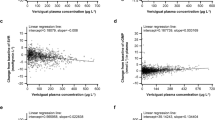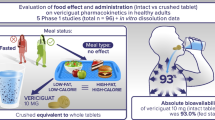Abstract
During development of a ranitidine effervescent oral solution dosage form, a marked decrease was observed in the extent of ranitidine absorption relative to the conventional oral tablet. Two studies were conducted in healthy volunteers to confirm the involvement of an excipient, SAPP (sodium acid pyrophosphate), and the mechanism of interaction, altered gastrointestinal transit. The first study (n = 12) involved single-dose crossover comparisons of (A) 150 mg ranitidine with 1132 mg SAPP versus (B) 150 mg ranitidine and (C) 150 mg ranitidine with all the effervescent tablet excipients except SAPP versus (D) a 150-mg ranitidine effervescent tablet, all administered as oral solutions. Serum ranitidine AUC, C max, and t max were compared using two one-sided t test 90% confidence intervals (CI). Comparing treatments A to B and D to C, all 90% CI were below the 80–120% range, indicating significantly less extensive ranitidine absorption (54% based on AUC) from the oral solutions containing SAPP. The second study (n = 12) was a single-dose crossover comparing 50 µCi 111InCl solutions with and without 1132 mg SAPP. Gastrointestinal transit times, determined by scintigraphic imaging, were compared between treatments. Gastric emptying time was unchanged, but small intestinal transit time was decreased to 56% in the presence of SAPP. More rapid small intestinal transit associated with an excipient of a solution dosage form apparently resulted in a decreased extent of ranitidine absorption. This observation contradicts the conventional wisdom that oral solutions are unlikely to fall short of bioequivalence relative to solid oral formulations.
Similar content being viewed by others
REFERENCES
Evaluation of the health aspects of phosphates as food ingredients. Report PB-262 651, Life Sciences Research Office, Fed Am Soc Exp Biol, 1975.
T. L. Lloyd, T. B. Perschy, A. E. Gooding, and J. J. Tomlinson. Robotic solid phase extraction and high performance liquid chromatography analysis of ranitidine in serum or plasma. Biomed. Chromatogr. 6:311–316 (1992).
M. M. Williams, G. E. Dukes, R. J. Han, W. D. Heizer, and L. J. Hak. Influence of gastrointestinal anatomic site of drug delivery on the absorption characteristics of ranitidine. Pharm. Res. 9:1190–1194 (1992).
C. J. C. Roberts. Clinical pharmacokinetics of ranitidine. Clin. Pharmacokin. 9:211–221 (1984).
L. L. Brunton. Agents affecting gastrointestinal water flux and motility, digestants, and bile acids. In A. G. Gilman, T. W. Rall, A. S. Nies, and P. Taylor (eds.), Goodman and Gilman's the Pharmacological Basis of Therapeutics, 8th ed., Pergamon Press, New York, 1990, p. 919.
Author information
Authors and Affiliations
Rights and permissions
About this article
Cite this article
Koch, K.M., Parr, A.F., Tomlinson, J.J. et al. Effect of Sodium Acid Pyrophosphate on Ranitidine Bioavailability and Gastrointestinal Transit Time. Pharm Res 10, 1027–1030 (1993). https://doi.org/10.1023/A:1018918907670
Issue Date:
DOI: https://doi.org/10.1023/A:1018918907670




